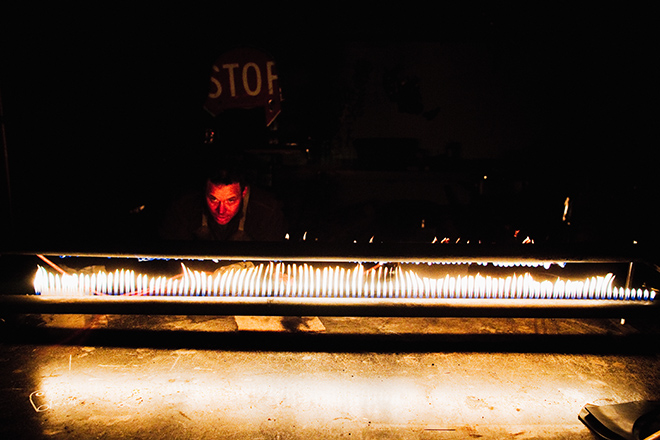SEATTLE — Rusty Oliver sets things on fire.
During our visit to his workspace, the aptly-named Hazardfactory, he demonstrated how two long propane-filled tubes can act as a kind of fiery audio EQ meter. He created a fierce ball of flame in the middle of a hoop-shaped sculpture he calls “The Singularity.” He showed off flame-throwing rayguns (sadly not currently in operation) and talked about how he was organizing a league to play one of his favorite sports, flaming tetherball.
And then, while standing next to several large propane tanks and a lot of gas-filled tubing, a visitor who was helping Oliver lit a cigarette.
No big deal, Oliver shrugged. If someone wants to set fire to the occasional cigarette in his shop, he’s OK with that.

This article is the first in a series of profiles about do-it-yourselfers and people who make amazing things.
Oliver, an artist, got into playing with fire after meeting Mark Pauline, the founder of Survival Research Laboratories, a San Francisco-area outfit that stages violent, destructive robot battles.
“It was the first kind of art I found really gripping,” says Oliver.
That was 10 or 15 years ago. Since then he’s made fire arts into a full-time business for himself. At Hazardfactory, a grungy but workmanlike space in Seattle’s industrial South Park district, he makes his artworks and does fabrication projects for clients, including Gabe Newell, the co-founder of Valve, the videogame publisher.
Oliver presides over the genial mess of his shop in a big leather apron and gloves. He’s got a ruggedly handsome face and the kind of big hands that could easily crush yours in a handshake if you aren’t careful.
When we visited, a few other people were there, sort of helping him and sort of just watching. Oliver teaches welding classes, sponsors power-tool drag-racer-construction workshops, and is organizing that flaming tetherball league.
He also does workshops with teenagers, teaching them how to weld and then setting them loose on a collection of scrap bicycles to see what rideable contraptions they can come up with.
Because Oliver’s sculptures are a little dangerous, he prefers to deliver them as performances rather than permanent installations. Watching him fiddle with the dials on multiple propane canisters, you can see that displaying a sculpture might be tricky.
About “The Singularity,” Oliver says, “I built this for a very specific purpose, which is to see if I could keep a ball of fire static in the middle.”
And he can. The sculpture looks simple: It’s a hoop of copper tubing with nozzles pointed inward toward the center. Propane feeds into it through two separate intakes. After some adjustment, he gets it dialed in.
A blue-white, blazingly hot ball of fire pulsates in the middle of the hoop. Everything else in the room fades into darkness, as we stare into the ever-changing heart of a naked, unchained furnace of flame.
The ball of fire is just a couple feet from our unprotected flesh, warming our faces like a miniature sun. Every time Oliver tweaks the dials, alarming yellow jets of fire bloom upward from the fireball. Somehow the warehouse doesn’t burn down.
He’s not above using fire to startle bystanders. At one recent gathering, Oliver says, he hooked up a propane jet to the bottom of a barbecue where he was cooking hamburgers. Whenever a customer asked for a toasted bun, Oliver would place it over the jet’s nozzle and stomp a foot pedal, triggering the flow of propane. A huge ball of flame would burst out of the grill with a gut-shaking WHOMP! and the bun, now charred to blackness, would go tumbling end over end into the air.
Oliver was also involved in a pilot for a Discovery Channel show called Weaponizers. He and three other builders created fully armed, full-sized, remote-controlled automobiles, which they then pitted against one another in an apparently no-holds-barred desert battle. The first episode of Weaponizers features lots of gratuitous explosions. It’s awesome.
As if fire weren’t enough, one of Oliver’s current projects is an effort to mix flame and high voltage. He starts with two “Rubens’ Tubes,” long perforated pipes through which propane flows, turning into flames at each opening. The pipes are connected to an audio source, and once he dials in the propane flow just right, the flames move in sync with the sound waves, forming a kind of burning EQ meter.
When Oliver runs current through the pipes, it arcs from one to the other and also does something hard to describe to the flames: Their shape changes, they become more compact, and the flames on the top start burning down, toward the lower pipe, instead of going up as flames normally do. Seeing that, you might start to see how electrical fields could be used to put out fires, as Harvard researchers recently demonstrated.
You can get a glimpse of the effect in the video below.
It’s an experiment, Oliver says, but even he isn’t entirely sure what the ultimate outcome will be. Mostly it’s a chance to mess around with dangerous stuff and see if he can produce some cool effects. Getting the best effects, it turns out, takes a lot of messing around.
“It’s iterative engineering,” says Oliver. “Hey, that didn’t work, let’s try again.”
Full story originally published on Wired: Fire Artist Mixes Propane, High Voltage | Gadget Lab | Wired.com.
